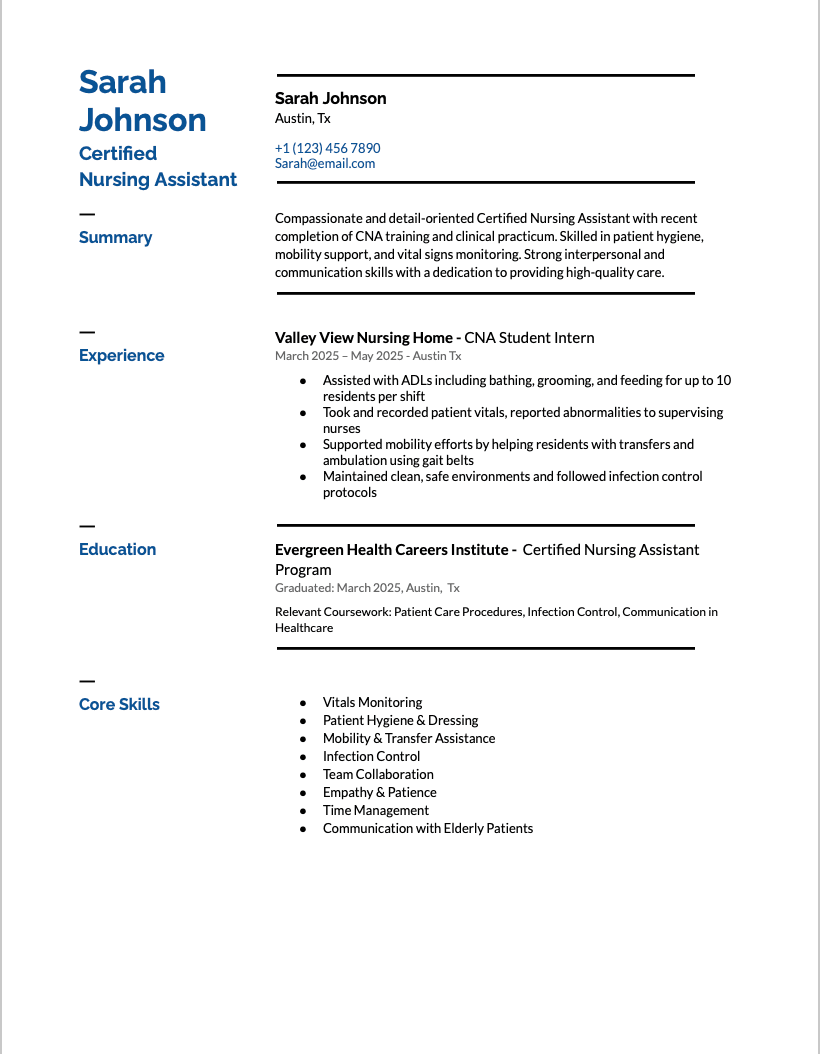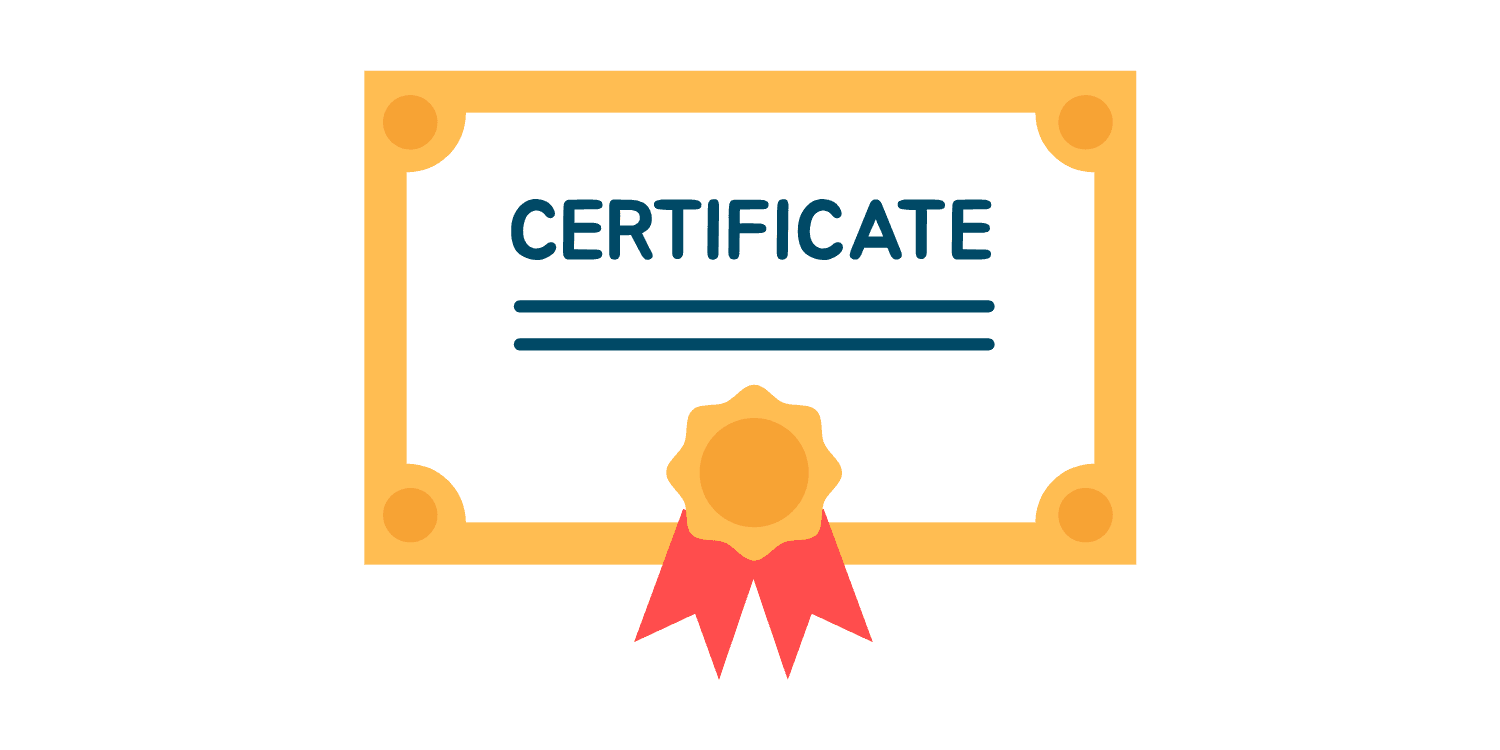CNA Resume Template & Examples to get you hired in 2025

Richard Shelton
Resume writing expert.
When you are writing a great Certified Nursing Assistant resume for yourself, it should stands out from the pool of other resumes, and for the same you need to craft specialised content that captures the nuances of nursing industry.
As you are well aware, CNA (Certified Nursing Assistant) is a demanding job with personal care and attention to detail, customized for each and every patient.
CNA resume should also be customized especially for specialized skills required for CNA with professional template and well structured points.
Expert's choice:
Get your CNA nurse resume crafted in minutes.
Get AI-crafted summary and bullet points with professional resume templates.
What Makes a Certified Nurse Assistant Resume Unique?
A CNA resume (Certified Nursing Assistant) is tailored to emphasize hands-on patient care, daily responsibilities, and compassionate support. Unlike RN resumes, a nursing assistant resume sample should showcase your ability to assist with:
- Daily hygiene and grooming
- Vital signs monitoring and documentation
- Patient mobility and positioning
- Basic medical tasks under RN supervision
What sets a CNA resume apart is its focus on direct bedside care and empathy-driven support.
Please make a point: employers are looking for CNAs who are not only dependable but also emotionally aware — since you're often the first point of contact for patients.
Unlike Registered Nurses, CNAs don't need to demonstrate care planning or medication administration. But your attention to detail, time management, and a strong work ethic are essential.
Highlight certifications, reliability, and your ability to comfort patients in high-stress environments.
Use action-oriented bullet points and tailor your CNA resume to the job posting for the best results.
CNA Resume Example

CNA Resume Format: What Works Best
Choosing the right CNA resume format can make or break your job application—especially when it comes to ATS (Applicant Tracking Systems).
The best format for CNAs is the reverse chronological layout.
Clearly lists your most recent experience first and is easy for recruiters (and ATS) to scan. For more information on everything professional nurse resume, check out our blog here.
To ensure an ATS-friendly CNA resume, follow these steps::
- Stick to a single-column layout
- Avoid graphics, tables, or unusual fonts
- Use standard section headings like "Experience," "Certifications," and "Skills"
- Incorporate keywords from the job description like vital signs, patient hygiene, mobility support
When it comes to file format, Word doc or PDF is usually best for design consistency—but only if it's properly formatted for ATS.
What to Write in a CNA Resume Example With No Experience
If you're just starting your career as a Certified Nursing Assistant, your CNA resume with no experience can still impress hiring managers. Focus on your education, certifications, and transferable skills.
Start with a professional summary which shows your personality. Summary which shows your passion for patient care and commitment to healthcare are the best.
Even if you haven't worked in a clinical setting yet, emphasize your reliability, communication skills, and ability to support patients with empathy.
Next, highlight your certifications, especially if you've completed a CNA training program or passed your state exam. Include important credentials like:
- Certified Nursing Assistant (CNA) License
- BLS or CPR Certification
- HIPAA or infection control training
In place of formal work experience, focus on clinical rotations, volunteer work, or even caregiving experience with family members. Use bullet points to describe what you did, such as:
- Assisted with bathing, feeding, and ambulation during training rotations
- Recorded patient vitals and maintained hygiene standards
- Supported nurses during basic medical tasks in a long-term care facility
Also include a Skills section with both hard and soft skills—like patient mobility, time management, compassion, and teamwork.
Even without experience, you can still create a compelling nursing assistant resume sample by showcasing your readiness to learn, passion for care, and CNA certification.
Top Skills to Include on a CNA Resume
Your CNA resume should reflect a balanced mix of hard skills and soft skills, tailored to patient care environments like hospitals, nursing homes, or assisted living facilities.

📌 Hard Skills for CNA Resumes
These technical skills prove you're ready for hands-on caregiving:
- ✅ Vital Signs Monitoring — Accurately checking and recording blood pressure, temperature, pulse, and respiration
- ✅ Patient Hygiene & Grooming — Assisting with bathing, oral care, dressing, and toileting
- ✅ Mobility Support — Safely transferring patients between beds, wheelchairs, or stretchers
- ✅ Feeding Assistance — Helping patients during meal times, including dietary monitoring
- ✅ Infection Control — Maintaining clean and sterile environments
- ✅ Charting and Documentation — Recording care activities and reporting to RNs or supervisors
- ✅ Basic First Aid — Recognizing emergencies and taking initial steps
📌 Soft Skills for CNA Resumes
These interpersonal qualities are just as vital in care-focused roles:
- 🤝 Compassion — Demonstrating empathy and emotional support during difficult times
- 🧠 Patience — Managing high-stress environments calmly
- 👥 Teamwork — Collaborating with nurses, doctors, and other healthcare staff
- ⏱️ Time Management — Handling multiple patients and tasks during shifts
- 🗣️ Communication — Clearly relaying patient updates to staff and comforting families
- 🧩 Adaptability — Adjusting to sudden changes in patient condition or care plans
How to Showcase Skills for a Nursing Assistant Resume
Use a separate Skills section on your CNA resume, and naturally embed the most relevant keywords throughout your experience section. For example:
"Provided mobility assistance to 6+ patients daily while monitoring vitals and maintaining accurate EMR documentation."
This shows you're qualified and keyword-optimized for ATS (Applicant Tracking Systems).
🛠️ Bonus Tip: Use a Visual Skill Checklist
Consider using checklists to break up text and draw attention to key abilities.
Including the right skills for nursing assistant resumes not only highlights your readiness for the role—it makes your application more discoverable by recruiters and automated hiring tools.
Certifications & Licensure for CNAs
Certifications play a crucial role in making your CNA resume stand out, especially if you're just starting your healthcare career or applying in a competitive region.
Employers often filter applications based on key licenses and trainings, so it's essential to include these prominently in your resume.

✅ CNA License
The foundation of any Certified Nursing Assistant resume is a valid state-issued CNA license. Make sure to list your license with the issuing state and license number (if applicable). For example:
Certified Nursing Assistant – California Department of Public Health | License #123456
✅ BLS/CPR Certification
Basic Life Support (BLS) and CPR certifications are often mandatory for CNA roles. These show you're trained to respond to cardiac or respiratory emergencies and can work effectively under pressure. Most hospitals and long-term care facilities expect this as a minimum qualification.
✅ HIPAA Compliance Training
Understanding patient confidentiality is a legal and ethical requirement. HIPAA compliance training proves you know how to handle sensitive medical data responsibly—an often-overlooked but valuable asset on a nursing assistant resume.
When using a smart resume tool like NurseResumeBuilder.app, your certification section is auto-formatted to highlight these credentials properly, making it ATS-friendly and visually clean.
📄 Example:
Certifications
- ✔ Certified Nursing Assistant – New York State Department of Health
- ✔ CPR & BLS Certified – American Heart Association
- ✔ HIPAA Compliance Training – 2025
Including these certifications boosts your credibility and increases your chances of getting shortlisted quickly.
Common CNA Resume Mistakes to Avoid
Even the most qualified nursing assistants can be overlooked due to errors in their resume.
Below are the most common mistakes seen on nursing assistant resumes—and how to fix them.
❌ Listing Generic Job Duties
Many candidates simply list basic responsibilities like "helped patients" or "provided care." These are too vague and do nothing to differentiate you. Instead, use action verbs and measurable results. For example:
- "Monitored vitals and documented changes for 10+ patients per shift"
- "Reduced patient falls by 20% by improving mobility assistance protocol"
Recruiters want to see impact, not job descriptions.
❌ Using Overdesigned Resume Templates
It's tempting to use flashy designs, icons, and multi-column layouts, but these often confuse ATS systems and result in your resume being rejected before a human ever sees it. Keep formatting clean and professional:
- Use standard fonts (Arial, Calibri, Times New Roman)
- Avoid graphics, tables, or color-heavy designs
- Stick to a single-column format
Tools like NurseResumeBuilder.app are built to ensure your resume is ATS-friendly and optimized for healthcare roles.
❌ Ignoring CNA-Specific Keywords
Without relevant keywords, your resume may never show up in search filters. Always include CNA resume skills and job-specific phrases like:
- "Patient hygiene and grooming"
- "Vital signs monitoring"
- "Mobility assistance"
- "Certified Nursing Assistant (CNA)"
These phrases match job descriptions and boost your visibility in applicant tracking systems.
❌ Forgetting to List Certifications & Licensing
Your CNA license, BLS/CPR certification, and HIPAA training should appear clearly in a separate "Certifications" section. Hiring managers scan for these first—leaving them out is a red flag.
By avoiding these common mistakes, you increase your chances of landing interviews and job offers faster. Make sure your CNA resume is tailored, metrics-driven, and aligned with industry standards.
FAQ
What should I include in a CNA resume?
Your CNA resume should include a professional summary, certifications (like CNA license and BLS/CPR), work or clinical experience, and relevant hard and soft skills. Be sure to include measurable achievements and keywords like "vitals monitoring" and "patient hygiene" to align with job descriptions and ATS systems.
Should I mention patient ratios?
Yes. Mentioning patient ratios shows your ability to manage workload and prioritize care. For example, "Cared for 8–10 patients per shift" provides context and demonstrates your time management and multitasking skills—qualities that recruiters actively seek in certified nursing assistants.
Can I get hired as a CNA with no experience?
Absolutely. If you're newly certified, focus your resume on clinical training, volunteer work, and relevant soft skills like empathy, teamwork, and adaptability. Highlight your certifications and any caregiving roles—even informal ones. Many facilities are open to training entry-level CNAs with the right attitude.
What's the best format for a CNA resume?
Use a clean, single-column reverse chronological format. It should be ATS-friendly—no fancy graphics or fonts. Standard headers like "Experience," "Skills," and "Certifications" make your resume scannable by both software and human reviewers. Consider tools like NurseResumeBuilder.app for perfect formatting.
How long should a CNA resume be?
Keep it to one page unless you have over 10 years of experience. Use concise bullet points that highlight your achievements, not just duties. A clear, focused resume increases your chances of passing ATS filters and catching a hiring manager's attention quickly.
Ready to Build Your Perfect CNA Resume?
Need help? Contact our team for any support.